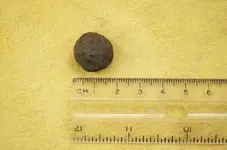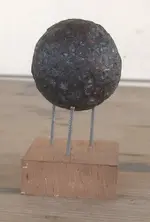Quijote wrote:
> There was a battle during 1846 in this area that did involve a 4-pounder cannon used by the Californios
> against the Americans. Is it possible that this is iron shot used in a cannon?
> How could I tell if it is a ball bearing or iron shot (possibly makeshift).
First... welcome to TreasureNet.

As my posting-name indicates, my specialty area in historical relic study is pre-1900s artillery projectiles. I've been doing that for almost 40 years, and wrote a major book on civil war artillery projectiles. (See the "About me" section in my TreasureNet member profile.) In my professional opinion, your approximately 17-millimeter/.70-inch iron ball is extremely unlikely to be an artillery ball, for the following reasons.
1- A 4-Pounder caliber cannon is a Colonial-era Smoothbore cannon. You say the battle took place in 1847. By the very-early 1800s, it had been discovered that Smoothbore cannon artillery balls smaller than 1-inch in diameter needed to be made of lead in order to have sufficient impact-force to be deadly (except, of course, at extremely short range). That is why there never have been any iron-bodied bullets. The British Army tested very-small-size iron artillery antipersonnel balls in the 1750s, and found that many failed to penetrate a wooden target.
Check the precise sizes of various artillery balls (cannon balls, Grapeshot balls, and Canister-ammo balls) in the US 1861 Ordnance Manual, here:
www.civilwarartillery.com/shottables.htm
You will see that the only artillery balls which are smaller than 1-inch diameter are 12-Pounder Howitzer Canister balls, which were lead musketballs. (See the chart on Canister ball sizes.)
Of course, there is at least a slight possibility that the Mexican Californios were using obsolete or "makeshift" cannon-ammunition contents in their obsolete Colonial-era 4-Pounder Smoothbore cannon. I'm just saying that the historical artillery data suggests it is highly unlikely that your 17millimeter/.70-inch iron ball is an artillery ball.
I should mention... antipersonnel artillery ammunition contained dozens of balls in EACH "round" of ammo. Therefore, a battlesite where antipersonnel artillery ammo was used tends to produce many dozens of that kind of ball -- not just one. If you eventually find several more balls exactly like the one you found at the dig-site, it would increase the (currently very slight) possibility that the ball is an artillery ball.
You asked "How could I tell if it is a ball bearing or iron shot (possibly makeshift)." That is a question which were cannonball-collectors (and scholars) frequently have to deal with, because of the existence of literally multi-millions of Civilian-usage (non-artillery) metal balls... such as rock-crusher balls used by the Mining-&-Stonemilling industry, other "pulverizer" balls, and ball-bearings, etc. So, we cannonball-collectors use the Ordnance Manual's precise size-&-weight charts for artillery balls, and we do very-precise measuring and weighing (using a digital caliper and a super-accurate Postal Shipping scale, to see if a ball's very-exact size-&-weight match up precisely with any of the artillery balls in the Ordnance Manual's specifications charts.
For example... the Manual's specifications say a 6-Pounder caliber Solid-Shot cannonball should be 3.58" in diameter, and weigh 6.1 pounds. So, if an iron ball measures (let's say) precisely 3.50" or weighs 6.5 pounds, it is not a cannonball.









